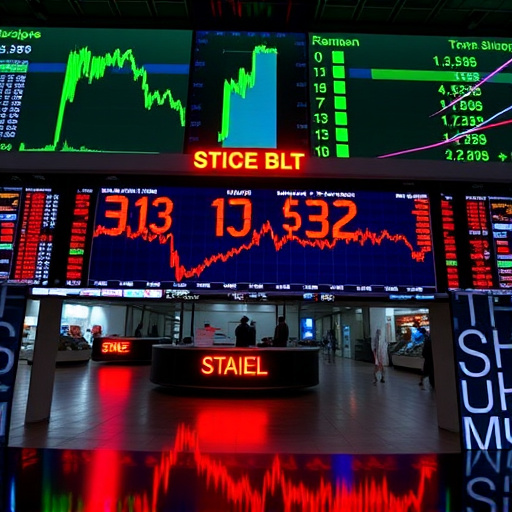Market liquidity is essential for traders, especially those engaging in leverage trading, as it determines the ease and fairness of asset transactions. High liquidity facilitates quick decision-making and risk mitigation during volatile markets, enabling traders to borrow funds (leverage) to enhance purchasing power for potentially higher returns. However, leverage amplifies risks; therefore, effective risk management through position sizing and understanding margin calls is crucial. The dynamic interplay between market liquidity and leverage trading is vital in the financial landscape, offering significant gains but also substantial risks that must be carefully balanced by traders seeking to optimize their strategies.
In the dynamic realm of trading, market liquidity and leverage are pivotal factors shaping investment outcomes. This article delves into these essential concepts, exploring how they interplay to influence trading performance. We begin by unraveling the fundamentals of market liquidity—its definition, importance, and impact on trade execution. Then, we dissect leverage trading: its potential for amplifying returns versus inherent risks. Subsequently, we analyze their symbiotic relationship, offering strategies to optimize both for enhanced trading success in today’s competitive market landscape, with a specific focus on leveraging trading techniques.
- Understanding Market Liquidity: The Foundation of Trading Success
- Leverage Trading: Unlocking Potential but Carrying Risk
- The Interplay Between Liquidity and Leverage on Trading Performance
- Strategies to Optimize Liquidity and Leverage for Better Trading Results
Understanding Market Liquidity: The Foundation of Trading Success

Market liquidity refers to the ease with which assets can be bought or sold in a market without significantly affecting their price. It’s a fundamental concept for traders, especially those engaging in leverage trading. When a market is liquid, there are ample buyers and sellers, ensuring that transactions occur swiftly and at relatively fair prices. This is crucial for leveraging trading strategies, where traders borrow funds to increase their purchasing power with the aim of generating higher returns.
High liquidity allows for efficient execution of trades, enabling traders to enter or exit positions promptly. This is especially important during volatile market conditions when quick decision-making can be a key differentiator. Leverage trading amplifies both gains and losses, so having access to liquid markets ensures that these effects are not compounded by slippage (the difference between expected and executed prices) or tight spreads (the difference between the bid and ask price).
Leverage Trading: Unlocking Potential but Carrying Risk

Leverage trading offers traders the potential to amplify their returns by borrowing funds to increase their buying power. This strategy can be a powerful tool for those seeking to maximize profits, especially in volatile markets where price movements can be rapid. However, it’s crucial to remember that this enhanced potential comes with significantly increased risk. The higher the leverage, the greater the potential loss if the market moves against the trader’s position.
Traders must carefully manage their exposure and understand the risks associated with leverage trading. A small adverse price move can lead to substantial losses, even resulting in margin calls where the broker demands additional funds or closes out the position to prevent further losses. Therefore, while leverage trading can unlock significant gains, it requires a high level of knowledge, discipline, and risk management strategies to navigate successfully.
The Interplay Between Liquidity and Leverage on Trading Performance

In the dynamic landscape of financial markets, the interplay between market liquidity and leverage is a delicate dance that significantly influences trading performance. Liquidity, essentially the ease with which assets can be bought or sold without affecting their price, acts as the lifeblood of efficient markets. When coupled with leverage trading—a strategy where traders borrow funds to amplify their purchasing power—it creates a powerful force that can either enhance or complicate trading outcomes.
Leverage, while offering the potential for substantial gains, introduces additional risk. High levels of liquidity facilitate the rapid execution of trades at favorable prices, allowing leveraged traders to capitalize on market movements swiftly. However, in illiquid conditions, where buying or selling a large position becomes challenging without impacting price, leverage can quickly turn into a double-edged sword. Traders must navigate these complexities, managing risk prudently to avoid unexpected losses that could outweigh potential gains from leverage trading.
Strategies to Optimize Liquidity and Leverage for Better Trading Results

Optimizing liquidity and leverage is a strategic move for traders aiming to enhance their performance in volatile markets. Effective management of these factors allows for more flexibility, enabling traders to seize opportunities swiftly. One key strategy is to maintain an adequate cash reserve, ensuring easy access to funds for immediate transactions. This reserves can act as a buffer during sudden market shifts, preventing forced sales at unfavorable prices.
Leverage trading, when executed prudently, amplifies both potential gains and losses. Traders should carefully assess their risk tolerance and use leverage accordingly. Utilizing technical analysis tools can help identify liquid assets and market trends, guiding informed decisions on when to employ leverage. Regular monitoring of open positions and adjusting strategies based on changing liquidity conditions is essential for successful optimization.
Market liquidity and leverage are powerful tools that, when understood and managed effectively, can significantly enhance trading performance. By optimizing these factors, traders can unlock greater opportunities, execute strategies with precision, and mitigate risks. Leverage trading, in particular, allows for substantial gains but demands careful consideration to avoid potential pitfalls. Embracing a strategic approach that balances liquidity and leverage is key to navigating the financial markets successfully and achieving better trading results.
